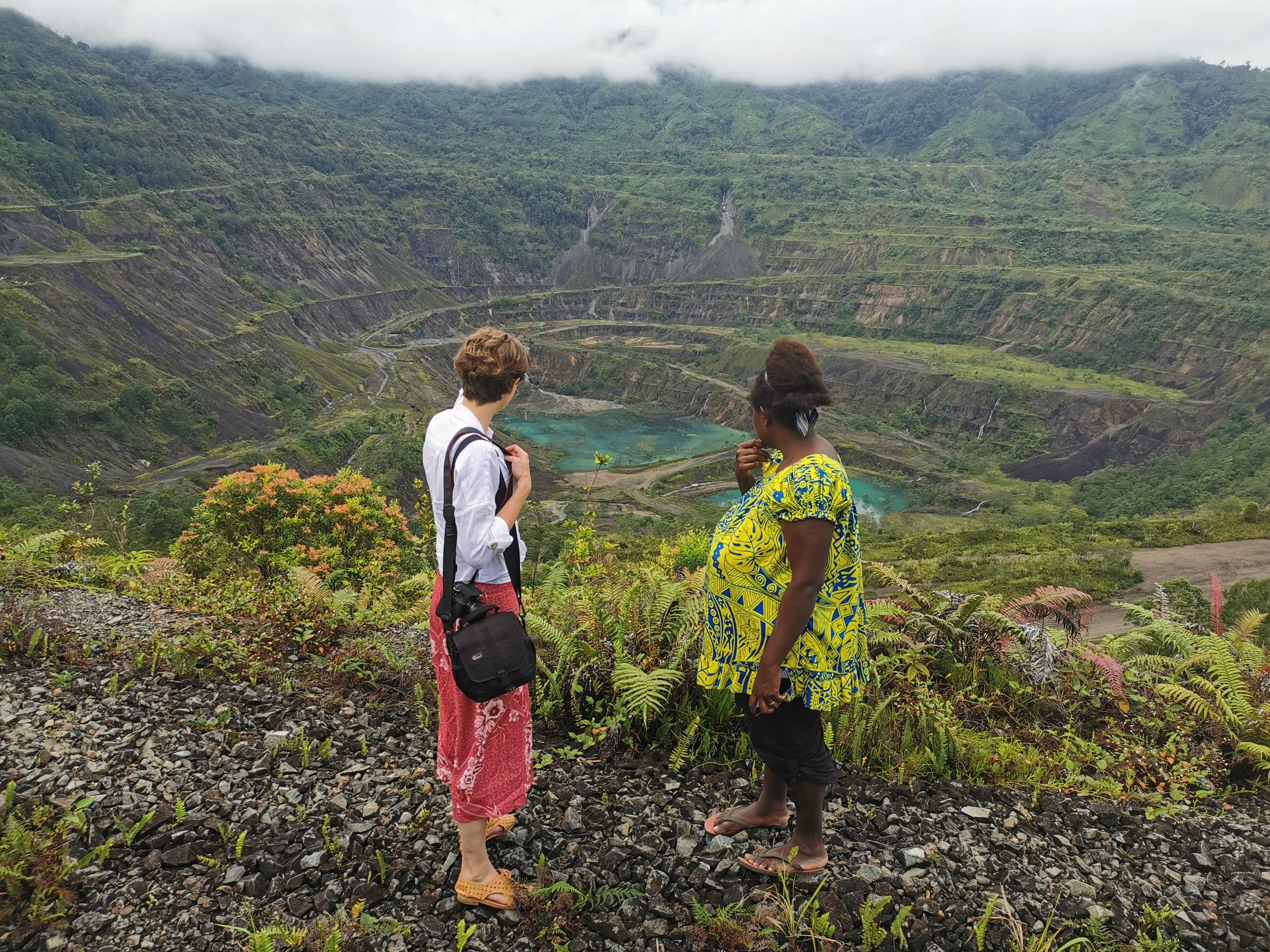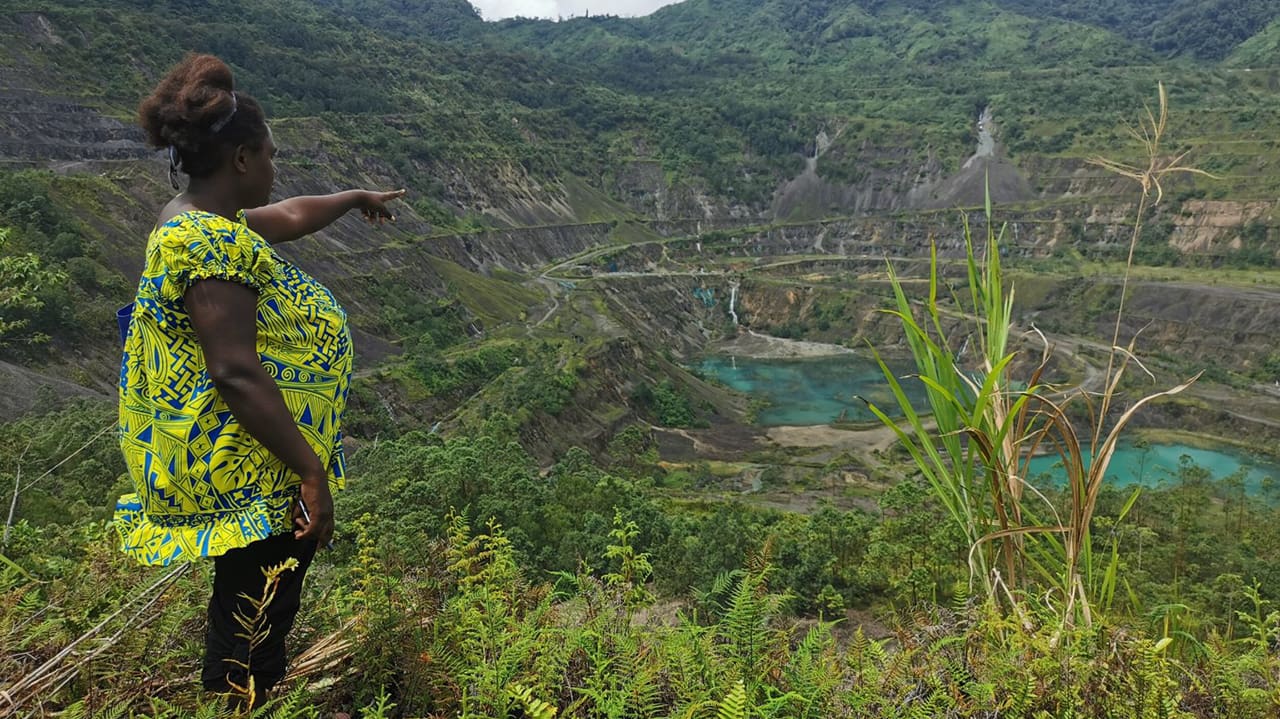Landmark investigation into former Rio Tinto Panguna mine confirms major environmental damage and life-threatening risks to communities
The Human Rights Law Centre is working with communities in Bougainville to seek justice for the environmental devastation left by Rio Tinto’s former Panguna mine.
Community leaders are calling on Rio Tinto to immediately commit to addressing public safety risks and funding long-term solutions, so people can live on their land in safety again.
Summary of Impacts
The investigation found serious environmental, social and human rights impacts in all mine-affected domains assessed.
“Since 1989, the mine has never re-opened and there has been no implementation of formal closure, maintenance of mining or process infrastructure or remediation work on the mine or downstream receiving environment. Mine structures and buildings have eroded and deteriorated, the tailings continued to migrate downstream and chemicals continue to be released over time from the open pit, waste rock dump and tailings, as well as some industrial chemicals associated with some mine buildings in the Mine, River System and Port & Town domains. Across the study area, this has resulted in a range of environmental, social, human health and human rights issues”
(Panguna Mine Legacy Impact Assessment Phase 1 Summary Report, p 23).
The Human Rights Law Centre has broken down the key findings of the environmental damage and human rights impacts to Bougainvillean people and communities from the former Panguna mine below.
-
River system impacts: “The Kawerong-Jaba River system has tailings from the mine all…along it to Empress August Bay. The physical impacts from the tailings have permanently changed the river system and it will not naturally return to how it was before the mine for at least 100 years.” (p v, Summary Report)
-
Pollution of the Kawerong river: “Since 1989, the amount of copper seeping from the waste rock dump has reduced by approximately 90%. Despite this, drainage from the waste rock dump, which flows into the Kawerong River, contains elevated metals concentrations and remains the main source of acid, copper and cadmium and a large source of sulfate to the downstream environment…” (p 32, Summary Report)
-
Impacts on fish and aquatic life: “…[P]hysical and chemical impacts to aquatic habitats…have continued since 1989…resulting in reduced abundance and diversity of aquatic plants and animals across various levels of the food chain, from algae to macroinvertebrates and fish”. (p 32, Summary Report)
-
Mine pit: “The stability of the Panguna open pit poses a safety risk to people living and undertaking ASM within it particularly in the eastern and southeast and southern slope” [ …] High and extreme risk is present regarding the unstable landform areas that could collapse including the south pit slope, the east pit slope as well as three areas of the Port to Mine Access Road”. (pp 41 & 44, Summary Report)
-
Landslides: “Around the mine there is the risk of landslides …[which] may kill or hurt people or block the main access road into Arawa. There are also areas of chemicals and metals in the soil and water and unstable buildings from the mine operations” (p v, Summary Report)
-
Collapsing mine levees: “Two sections of the Main/Pump Station Levee may collapse in the future either due to levee failure or liquefaction. Failure of Section 1 […] would affect around 50 households, and Section 2 […] would affect around 30 households. Areas used for communal purposes and resource collection would also be affected, increasing the likelihood that rightsholders may be at risk of injury, disability, or death.” (p 69, Summary Report)
-
-
Flooding: “Mine-related flooding in the Jaba-Kawerong River system disrupts community access to essential infrastructure and services. When floods happen, areas without safe crossings, like bridges, become inaccessible, impacting peoples’ ability to reach health facilities, go to school and buy and sell goods, including essential goods such as food.” (p 61, Summary Report).
-
Dangerous river crossings: “Certain areas of the Kawerong-Jaba River pose a greater hazard for people crossing the river due to quicksand and unstable riverbeds created by the tailings, affecting community safety and access to services”. (p v, Summary Report).
-
-
-
Water security: “Tailings in the Kawerong-Jaba River system have changed flooding activity in Kuneka Creek, lower Pagana River and the lower Tun Creek. Flooding in these water courses impacts water sources (eg. creeks) and reduces the overall acceptability of water sources, result in an…impact on water security for communities, including Namunsa and Mokerokeroai”. (p 62, Summary Report)
-
Drinking water: Community drinking water samples collected during Phase 1 did not pose a risk to human health from mine-related chemicals or metals, except for drinking water from the mine-pit and Jaba-Kawerong River. (p v, Summary Report)
-
-
-
Potential chemical hazards: “Chlorine cylinders at the former sewage treatment plant ..and at the former Camp 11 chemical storage warehouse could release chlorine gas which has the potential to impact the right to life for individuals from nearby communities. Th[ese] site[s] have been included conservatively as the condition and quantity of chemicals at these sites is unknown, (pp 89 and 93, Summary Report)
-
Chemical explosion hazards: “Three sites may also pose an explosive risk: the bulk fuel storage tanks and spill; reagent storage areas (KMH areas 1 and 3); methyl isobutyl carbinol storage tanks and bund. These sites.. have been included precautionarily as it was not possible to confirm the condition and quantity of chemicals.. The chemicals may have degraded reducing the risk of an explosion.” (p.89, Summary Report
-
Chemicals in soil (in some locations): Chemicals from mine-related infrastructure and activities have entered the soil in areas of the Port and Town Domain, including lead, PCBs, iron, hydrocarbons and PFAS…Chemicals were above the residential health (direct contact) criteria in soil samples in four locations in Anewa Bay: reagent storage tanks, Loloho fire station, bulk fuel store area, and the Shell oil fuel storage terminal. This means that soil in these areas poses a possible health risk for people who have regular skin contact with this soil, or if they eat or inhale this soil. (p 87 Summary Report)
-
-
-
Loss of productive land: “In some locations, tailings may be covering good quality land and soil that could otherwise be available for natural vegetation and growing gardens…Plant growth is likely to be affected by chemicals and lack of nutrients in the tailings.” (p 49, Summary Report)
-
Contaminated soil: “There are areas of chemicals in the soil and water [which] could also harm people. Some soil and food have high levels of metals that require further investigation, but eating food grown in the area…was found to be low risk”.
-
Bush resource collection lost: “New areas covered by tailings since 1989 include Konaviru Wetland and the Northern Tailings Breakout, smothering vegetation and fundamentally changing the ecosystem…Affected resources include gathering palm leaves for house construction and repair, food and hunting and fishing targets. The value of the Konaviru Wetland bush resource collection has been completely lost.” (p 60, Summary Report).
-
- Cultural impacts: Based on available information it is almost certain that sacred sites have been affected by changes in the extent of flooding and tailings deposition since 1989 and that this has had an actual impact on the cultural rights of customary groups […] Areas where sacred sites have potentially been impacted include but are not limited to flood impact areas in the Lower tailings sub-domain. The loss of sacred sites has a flow on effect of preventing and interrupting participation in customary practices. (p.12-76 Main report)

The Panguna Mine Legacy Impact Assessment was funded by Rio Tinto in response to a human rights complaint brought by local community members represented by the Human Rights Law Centre.
The two-year investigation, undertaken by environmental firm Tetra Tech Coffey, focused on the most serious areas of concern to communities, and was the largest study of its kind ever undertaken in Bougainville.
Panguna was formerly one of the world’s largest copper and gold mines. Close to a billion tonnes of mine waste were released directly into the Jaba and Kawerong rivers during the operation of the Panguna mine between 1972 and 1989. In 1989, an uprising by local people against this environmental destruction and inequities in the distribution of the mine’s profits forced the mine to stop operating and triggered a brutal decade-long civil war.
No clean-up has ever taken place.
Communities have called on Rio Tinto to contribute to a substantial, independently managed fund, to help address the harms caused by the mine and assist long term rehabilitation efforts, as well as participating in reconciliation as per Bougainvillean custom.
Rio Tinto has not yet committed to funding the long-term solutions and clean-up which communities have been calling for but recently entered a Memorandum of Understanding with the Autonomous Bougainville Government and Bougainville Copper Limited to establish a Roundtable to discuss a potential remedy mechanism.
Meanwhile, local people continue to live with the devastating impacts of the mine. Mine infrastructure is crumbling, putting lives at risk. Villages are being flooded and communities cut off from access to water and essential services.
The Human Rights Law Centre will continue working with communities to ensure Rio Tinto takes responsibility for its legacy.




